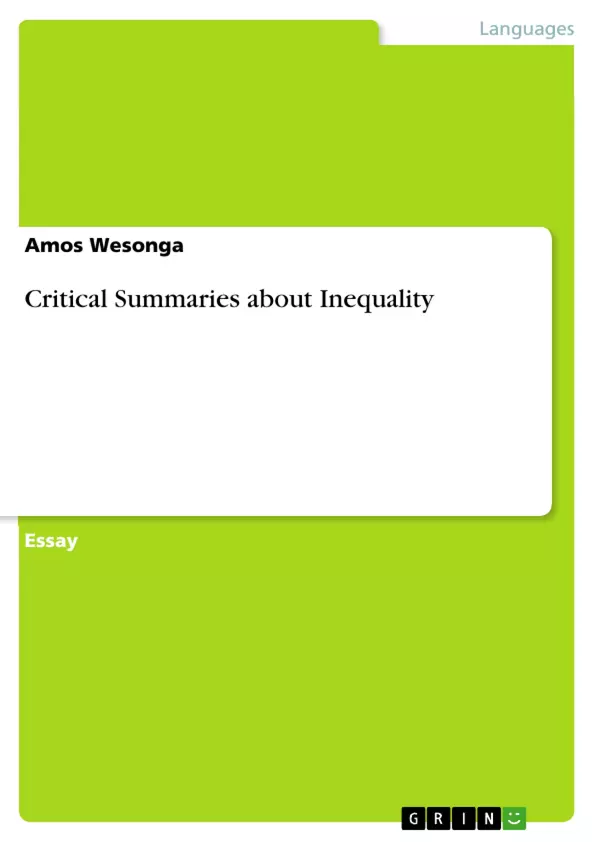Joan, as the author of this piece, focused on how to comprehend race, class, and gender as converging processes. Further, she paid attention to the impediments of establishing equality in work institutions. In light to this, the focus of this piece will be to evaluate concisely and from a critical point of view why the idea of inequality regimes is important in scrutinizing institutional change program in a bid to determine the rationale behind the success of some programs as others fail, providing the strength and weakness of each aspect involved.
Inhaltsverzeichnis (Table of Contents)
- Inequality Regimes: Gender, Race, and Class in organizations
- The Bases of Inequality
- Institutional Activities Leading to Inequality
- Inequality Awareness
- Economic Inequality of the badli workers of Bangladesh: Contested entitlements and a 'perpetually temporary' life-world
- Conceptualization of Economic Discrimination
- Origin and Advancement of the badli System
- Emergence of the Khalispur Industrial Township
- Managing masculinity/mismanaging the corporation
- Masculinity Management and Mismanagement of Corporation
- Interrogation on the Bank's Financial Crisis
- Swedish Wrongdoings
Zielsetzung und Themenschwerpunkte (Objectives and Key Themes)
This piece explores the complexities of inequality regimes within organizations, analyzing how gender, race, and class intersect to create and sustain unequal power structures. It examines the historical roots of these inequalities and their impact on various aspects of organizational life, including recruitment, hiring, job design, and wage disparities.
- The interplay of gender, race, and class in creating and maintaining inequality regimes.
- The role of institutions and organizational practices in perpetuating inequality.
- The impact of inequality on individual and organizational outcomes.
- The importance of awareness and action to address and dismantle inequality.
- The role of government regulation in mitigating financial crises and promoting fair practices in the banking sector.
Zusammenfassung der Kapitel (Chapter Summaries)
- Inequality Regimes: Gender, Race, and Class in organizations
- This chapter examines how gender, race, and class intersect to create and maintain inequality within organizations. It analyzes the historical roots of these inequalities and their impact on recruitment, hiring, job design, and wage disparities.
- This chapter explores the role of institutional practices and structures in perpetuating inequality. It analyzes how organizational processes and hierarchies can reinforce existing power imbalances.
- This chapter focuses on the importance of awareness and action in addressing inequality. It analyzes how individual and organizational perceptions of inequality shape responses to these challenges.
- Economic Inequality of the badli workers of Bangladesh: Contested entitlements and a 'perpetually temporary' life-world
- This chapter investigates the concept of economic discrimination, drawing upon the theories of Sen and Marx. It examines how economic inequalities can extend beyond income disparities to encompass social, political, and civil status.
- This chapter explores the origins and development of the badli system in Bangladesh, examining the historical context and legal framework surrounding this form of temporary employment.
- This chapter analyzes the emergence of the Khalispur Industrial Township, examining the social, economic, and political factors that contributed to its development. It highlights the challenges and inequalities faced by workers in this context.
- Managing masculinity/mismanaging the corporation
- This chapter explores the relationship between masculinity management and corporate mismanagement. It examines how traditional notions of masculinity can contribute to organizational failures.
- This chapter analyzes the bank's financial crisis, examining the role of risk-taking behaviors and the dominance of men in senior management positions.
- This chapter examines the impact of gender inequality on the Swedish banking sector, highlighting the detrimental effects of male-dominated leadership and the need for greater gender sensitivity.
Schlüsselwörter (Keywords)
The key focus of this work lies in understanding the intersections of gender, race, and class within organizational structures. This includes examining the consequences of discriminatory practices, the perpetuation of inequality through institutional mechanisms, and the impact of these dynamics on individual and organizational outcomes. Additionally, the text emphasizes the importance of awareness and action in addressing these issues, exploring ways to dismantle discriminatory systems and promote equitable practices within workplaces. Furthermore, the work delves into the role of government regulation in mitigating financial crises and fostering responsible corporate behavior.
- Quote paper
- Dr. Amos Wesonga (Author), 2017, Critical Summaries about Inequality, Munich, GRIN Verlag, https://www.grin.com/document/441281



